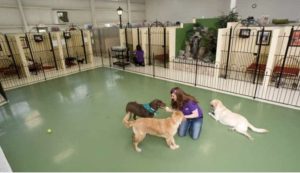Maintaining our dog’s training and behavioral skills is critical, even when they are temporarily boarded.
Boarding a dog may be necessary for a variety of reasons, including vacations, business trips, or family emergencies. However, the change in surroundings can cause bad behavior, manners, and even food habits that may jeopardize the many training gains we’ve accomplished with our cherished dogs.

This article tries to provide useful techniques and tips for keeping your dog’s training intact when they are boarded.
You may assist and train your dog in using new skills, keeping well-learned skills, and returning home with little relapse by planning lessons ahead of class time, properly using food, communicating with the boarding facility, and adopting consistent training strategies.
Importance of Maintaining Dog Training during Boarding
When it comes to our animal pals, we always want them to be on their best behavior. But what if you have to leave town and have to put your pet pup in a boarding facility?
The last thing you want is for all of their hard work to be for naught. That is why it is critical to keep your dog’s training going when they are boarded.
We’ll look this week at some tips, new tricks, tips, and tactics for keeping crate training and your dog’s training on track even while you’re not around.
How to Maintain Your Dogs Training While They’re Boarded
1. Planning Ahead: Preparing Your Dog for Boarding
It’s critical both you and the trainer have to lay the framework for your dog and puppy’s success before dropping them off at the boarding facility. Here are a few things you the owner and trainer can do:
Assessing Training Needs and Goals
- Consider your dog’s training requirements and goals. Do you wish to reinforce any specific directives or behaviors while they’re boarded? Perhaps you’ve been working on leash manners, or perhaps you’re concentrating on obedience training. Knowing your training priorities will assist you in guiding your contacts with the boarding facility.
Selecting a Boarding Facility that Supports Training
- When it comes to supporting and reinforcing training, not all boarding facilities are made equal. Look for a facility with personnel that has been trained in dog behavior and training techniques. Inquire about their training methods and determine whether they are appropriate for your dog’s needs. Choosing the appropriate facility can make a huge impact on your dog’s training.
Familiarizing your Dog with the Boarding Routine
- Dogs, like people, thrive on routine. Before you board your dog, ask the company what their schedule is so you can ensure your dog is getting the proper mental and physical exercise during their boarding stay.. As a result, you can decide on a boarding facility with a staff that can sustain your dog’s training.
2. Communicating with the Boarding Facility: Sharing Training Techniques and Routines
Communication between trainers is essential for ensuring obedience is the correct behavior and that your dog’s training does not lapse while they are boarded. Consider the following fundamental obedience lessons and communication strategies:
Providing Detailed Training Instructions
- When you drop off your dog at the boarding facility, make sure to give them detailed training instructions. Explain your precise directives, strategies, and reinforcement systems. The more information you provide, the more equipped the team will be to continue training your dog.
Scheduling Training Sessions with Boarding Staff
- If your dog requires regular training sessions, see if you can schedule your dog for enrichment sessions during their stay. This way, you can ensure that training continues consistently. Discuss the frequency and duration of the sessions to match your dog’s training routine.
Requesting Progress Reports and Feedback
- Don’t be afraid to ask for progress reports and feedback from the boarding facility. Request that they keep you updated on how your dog is progressing with their training.
3. Consistency is Key: Reinforcing Basic Commands and Behaviors
Once your dog is settled into daily life at your house or the boarding facility, it’s time to train them to focus on reinforcing their basic commands and behaviors. Here’s how you can teach and train your dog can do it:
Reviewing Essential Commands Before Boarding
- Take some time before dropping off your dog to go over important instructions. Go over the fundamentals, such as their basic obedience commands. This refresher will remind your dog of the rules, making it easier for the boarding staff to reinforce these commands.
Practicing Commands in the Boarding Environment
- Encourage the boarding crew to rehearse commands in the boarding area. This will assist your dog in generalizing their training and understanding that the rules apply regardless of place. It’s an excellent technique to guarantee that their training is consistent.
4. Exercise and Mental Stimulation: Keeping your Dog Active and Engaged
Incorporating Physical Exercise into Boarding
- When your pet is boarded, they must continue to obtain adequate physical exercise. Inquire with the boarding facility about regular exercise regimens or if there is a specific play area where your pet can stretch their legs. A tired dog is a happy dog, so look for a boarding facility that appreciates the value of keeping your dog active.
Engaging Your Dog with Mental Stimulation Toys and Games Because boarding can be stressful for dogs, providing them with mental stimulation is crucial. Pack their favorite puzzle toys or interactive brain-challenging activities.
This same reward method will keep kids busy while learning while also preventing boredom separation anxiety and anxiousness. Plus, who doesn’t enjoy the reward of witnessing their dog’s “a-ha” moment after solving a puzzle?
. Return and Reinforce: Re-establishing Training at Home after Boarding
- Transitioning from Boarding to Home Environment – It’s critical to give your dog time to acclimatize to their schedule once they’ve returned home.
- Refreshing Training Commands and Routines – It’s typical for dogs to be rusty with their training commands after a time of separation. Spend some time going over the fundamentals and refreshing their memory. Begin with simple instructions such as “sit,” “stay,” and “come,” which will help them restore focus and strengthen their training foundation.
Your dog may confront new problems or exhibit new habits while boarding. Don’t be alarmed! It is natural for dogs to adjust after being away for an extended period of time. Maintain your cool and examine any concerns that occur.
Keeping your dog’s training while they are boarding is critical for their overall well-being and your peace of mind.
Remember that the keys to your dog’s training and success are consistency and clear communication. You may have a fun and worry-free boarding experience knowing that your furry friend’s training is intact if you plan ahead of time and pay attention to training basics.
More articles like this:
The Ultimate Guide to Successful Dog Boarding and Training
Top Signs Your Dog Needs Training and Boarding Services
Common Mistakes to Avoid When Boarding and Training Your Dog
